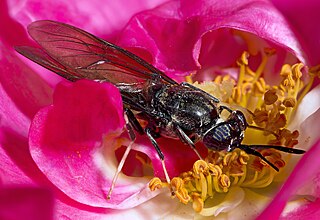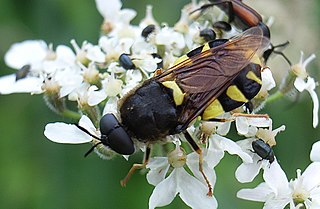
The soldier flies are a family of flies. The family contains over 2,700 species in over 380 extant genera worldwide. Larvae are found in a wide array of locations, mostly in wetlands, damp places in soil, sod, under bark, in animal excrement, and in decaying organic matter. Adults are found near larval habitats. They are diverse in size and shape, though they commonly are partly or wholly metallic green, or somewhat wasplike mimics, marked with black and yellow or green and sometimes metallic. They are often rather inactive flies which typically rest with their wings placed one above the other over the abdomen.

Hermetia illucens, the black soldier fly, is a common and widespread fly of the family Stratiomyidae. Since the late 20th century, H. illucens has increasingly been gaining attention because of its usefulness for recycling organic waste and generating animal feed.

Stratiomyini is a tribe of flies in the family Stratiomyidae.

Oxycera is a genus of flies in the family Stratiomyidae.

Nemotelus is a genus of soldier flies in the family Stratiomyidae. Nemotelus is known from the Nearctic, Afrotropical and the Palaearctic regions.

Chorisops is a genus of flies in the family Stratiomyidae.

Beris is a genus of flies in the family Stratiomyidae. They are also referred to as the false soldier fly. As described by Latreille in 1802, these are small to medium sized flies with metallic colors.

Actina is a genus of flies in the family Stratiomyidae.

Stratiomyinae is a subfamily of flies in the family Stratiomyidae.

Beridinae is a subfamily of soldier flies in the family Stratiomyidae.

Clitellariinae is a subfamily of flies in the family Stratiomyidae.

Pachygastrinae is a subfamily of flies in the family Stratiomyidae.

Sarginae is a subfamily of soldier flies in the family Stratiomyidae.

Cyphomyia is a genus of flies in the subfamily Clitellariinae.

Adoxomyia is a genus of soldier flies in the family Stratiomyidae.
Caloparyphus is a genus of flies in the family Stratiomyidae.
Lasiopa is a genus of flies in the family Stratiomyidae.
Brachyodina is a genus of flies in the family Stratiomyidae.

Chalcidomorphina is a genus of flies in the family Stratiomyidae.
Eidalimus is a genus of flies in the family Stratiomyidae.














